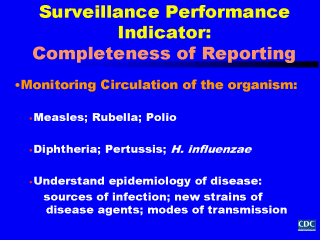| front |1 |2 |3 |4 |5 |6 |7 |8 |9 |10 |11 |12 |13 |14 |15 |16 |17 |18 |19 |20 |21 |22 |23 |24 |25 |26 |27 |28 |review |
 |
When monitoring diagnostic effort reveals few to no cases of disease, monitoring for circulation of the causative infective agent becomes important, especially as an adjunct assessment tool to monitoring diagnostic effort. Examples of ways in which circulation of infective agents is monitored include viral molecular typing for measles, rubella, and polio, and bacterial typing for diphtheria, pertussis, and H. influenzae. If we are aware that an infective agent is still present in the environment, then it is likely that cases of disease are still present in the community. If these cases are not being reported to our surveillance system, we need to determine why this is so and improve our surveillance efforts so that we are able to identify them. Monitoring for circulation of organisms also provides information important to understanding the epidemiology of diseases. Such information includes identification of multiple sources and new strains of disease-causing agents, and the ability to differentiate between endemic versus imported transmission of disease. Molecular epidemiology has been critical to demonstrating the interruption of indigenous measles transmission in the United States and the continuing role importation plays in determining the annual burden of disease. In the future, as the incidence of many diseases decrease and goals for their geographic elimination are developed, monitoring for circulation of their causative agents will become an essential component of surveillance activities to verify their actual absence in the environment, a requirement for certification of worldwide eradication. While monitoring circulation of organisms is most relevant to surveillance of infectious and vaccine-preventable diseases, we can also conduct monitoring for the presence of toxins to evaluate the completeness of reporting in surveillance systems focused on environmental and occupational hazards and health conditions. Similarly, monitoring for the presence of risky behaviors and/or absence of health-promoting behaviors as associated, if not causative, agents for injuries and chronic diseases can also be carried out to assess completeness of reporting in for these surveillance systems. |
| front |1 |2 |3 |4 |5 |6 |7 |8 |9 |10 |11 |12 |13 |14 |15 |16 |17 |18 |19 |20 |21 |22 |23 |24 |25 |26 |27 |28 |review |